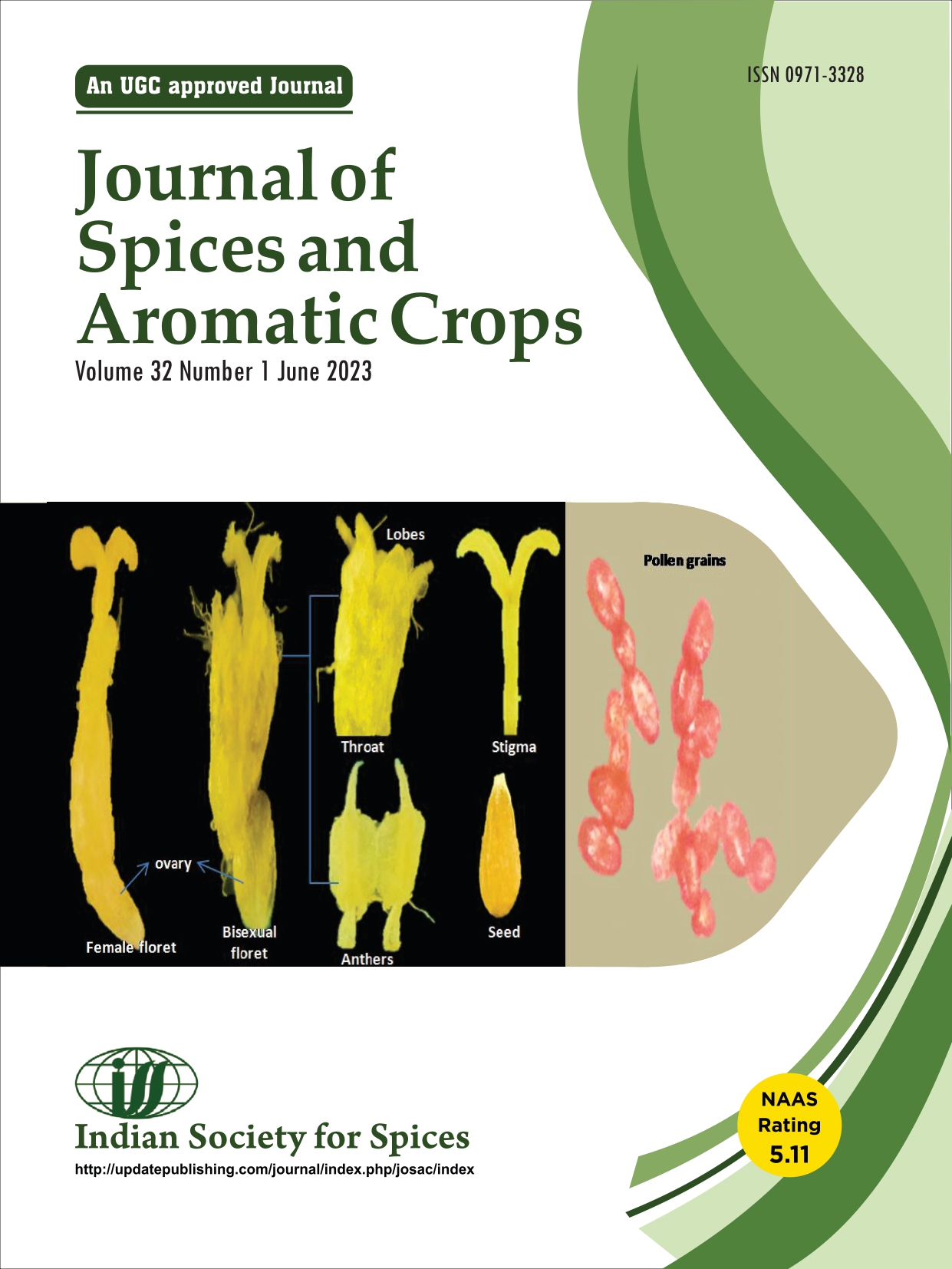Report on association of plant parasitic nematodes in large cardamom (Amomum subulatum Roxb.) at Sikkim, Himalaya region of India
Plant parasitic nematodes in large cardamom in Sikkim
DOI:
https://doi.org/10.25081/josac.2023.v32.i1.8593Keywords:
Nematode, large cardamom, association, soil and rootAbstract
Large cardamom (Amomum subulatum Roxb.), is a major cash crop grown in Sikkim Himalaya region. The crop is found to be affected by many pests (insects and diseases); which hinders the production, productivity as well as quality of the produce. Based on symptoms in this crop, similar to nematode infestation, soil and root samples were collected from the rhizosphere of different large cardamom fields and analyzed for presence of nematodes. Laboratory analysis revealed the association of six nematode species with large cardamom viz., Meloidogyne incognita, Helicotylenchus spp., Hoplolaimus sp., Tylenchorhynchus annulatus, Pratylenchus sp. and Macroposthonia spp., of which Meloidogyne incognita and Pratylenchus sp. were recorded in roots also and the percentage of occurance was 59.09. Apart from Meloidogyne incognita, all other five nematode species were recorded for the first time in large cardamom. Helicotylenchus spp. was the dominant genera among the six genera with 50% occurrence, 61.56 % relative abundance and 60 nematodes per 200 cc soil.
Downloads
References
Ali S S & Koshy P K 1982 Occurrence of root knot nematodes in cardamom plantations of Kerala. Nemato. Medit. 10: 107–110.
Anonymous 2015 https://search.ipindia.gov.in/GIRPublic/Application/Details/376 accessed on 19 June, 2023.
Anonymous 2022 Major spice state wise area production. www.indianspices.com
Ayoub R M 1977 Plant Pathology an Agricultural training Aid. State California, Dept. Food and Agric. Sacromento, USA,156p.
Christie J R & Perry V G 1951 Removing nematodes from soil. Proc. Helminthol. Soc. Wash. 18:106–108
Deka T N, Gudade B A, Saju K A & Bora S S 2016 Insect and Mammalian Pests of Large Cardamom (Amomum subulatum Roxb) in Sikkim Himalaya. Vegetos 29: 3
Goodey T & Goodey J B 1963 Soil and freshwater nematodes. Butler and Tanner Ltd, London, Great Britain.
Gudade B A, Chhetri P, Gupta U, Bhattrai N K, Deka T N &Vijayan A K 2014 The study on ecofriendly practices of large cardamom (Amomum subulatum Roxb.) cultivation in Sikkim and Darjeeling region. Ecol, Environ and Conserv 20 (01): 119–123.
Gudade B A, Harsha K N, Vijayan A K, Chhetri P & Deka T N 2015 Effect of foliar application of Zn, Mn and Mg on growth and nutrient content in large cardamom (Amomum subulatum Roxb.) at Sikkim. Int. J. Farm Sci. 5 (1): 51–55.
Gupta U & Chhetri P 2013 Performance of selected accessions of large cardamom germplasm under preliminary evaluation trial. Green Farming 4 (5): 670–671.
Mai W F & Lyon H H 1975 Pictorial key to genera of plant-parasitic nematodes. Ithaca, NY: Cornell University Press, USA.
Norton D C 1978 Ecology of Plant-Parasitic Nematodes. John Wiley and Sons, New York City, NY, 268p.
Raj C, Singh S, Kalita H, Avasthe R K, Gopi R, Singh M, Kapoor C, Kumar R & Singh N J 2021 Prevalence of insect pests in large cardamom (Amomum subulatum Roxb.) and evaluation of bio-rationals for the management of major pests under organic agroecosystem of Sikkim. J Spic Arom Crops 30 (1): 42–49.
Rao Y S, Gupta U, Kumar A & Naidu R A 1993 A note on large cardamom (Amomum subulatum Roxb.) germplasm collection. J Spic Arom Crops 2: 77–80.
Thakur Azad, N S & Sachan J N 1987 Insect pests of large cardamom (Amomum subulatum Roxb.) in Sikkim. Bulletin of Entomology 28: 46–58.
Varadarasan S & Biswas A K 2002 Large cardamom (Amomum subulatum Roxb.) In: Cardamom: The genus Elettaria, Ravindran P N & Madhusoodanan K J (Eds.) CRC Press. Taylor & Francis, London 319p.
Published
How to Cite
Issue
Section
Copyright (c) 2023 S S Bora, Debanand Das, Binita Basumatary, D Ajay, T N Deka, S L Bhutia, L O Pakhrin, A B Remashree

This work is licensed under a Creative Commons Attribution-NonCommercial-NoDerivatives 4.0 International License.






 .
.